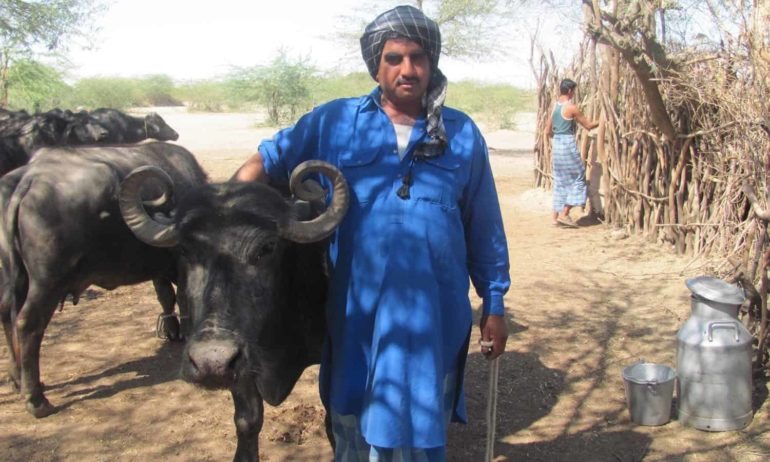It was the “together-we-can” approach of pastoralists of Banni, a 3,847-square-kilometer stretch of dry grassland on the northern border of the Kachchh district in the western Indian state Gujarat, that helped the community tide over environmental crises of flawed government policies and frequent droughts.
With encouragement from the non-governmental organization Sahjeevan, the pastoralists (known locally as Maldharis) formed the Banni Breeders’ Association in 2008. The group, now a registered trust, was able to pressure the government into discontinuing its program of fencing the communally-used Banni grasslands, which deprive their night-grazing free-range livestock of food and habitat. The pastoralists said that the government wanted to give this land to business units for setting up their industrial units.
The Breeders’ Association also organized an animal fair (Banni Pashu Mela) to showcase their livestock wealth, particularly the Banni buffalo—lovingly called the “pride of Banni.” The animal fair presents the Maldharis with a unique opportunity to educate people from other parts of the country on the distinct animals of Banni.
Banni Pashu Mela has become an annual affair, attracting traders from all over India and outside it. Top government officials formally inaugurate the fair, giving Maldharis a chance to discuss their problems with political representatives. “The animal fair has opened a window for us to negotiate with the government,” said Maldhari Imran Ahmed.
More than 1,000 animals trade hands during the festival, as the buyers and sellers strike on-the-spot deals. Moreover, the event holds competitions for best male and female buffalo, best bull, and best cow, which encourage the breeders to continuously improve the quality of their stock.
The Breeders’ Association facilitated collaboration with buffalo breeders, scientists, government officials, and NGO workers to secure national breed recognition for the Banni Buffalo. The Maldharis believed their buffalo had unique production and habitation characteristics that differentiate it from rest of the breeds in India, but had no idea how to prove it. “We discussed it with the representatives of Sahjeevan, who helped us to take up this issue with the relevant quarters,” said Salemamad Halepotra, a Maldhari.
At the directions of scientists from Sardarkrushinagar Dantiwada Agricultural University, select members of the Banni Breeders’ Association spent around a year closely monitoring a test group of buffalo and collecting data. Based on the Maldharis’ findings, the scientists prepared a breed descriptor and sent the registration application to the National Bureau of Animal Genetic Resources (NB AGR), the responsible body for recognition of breeds in India.
In 2010, the Banni Breeders’ Association successfully registered the Banni Buffalo as India’s eleventh buffalo breed. The community is the first in India to gain official recognition for their conservation and development of a breed.
During the breeders’ hard work to achieve recognition, word spread about the Banni Buffalo’s qualities. The drought-resistant buffalo has excellent reproductive efficiency and incredible milk production—an average of 19 kilograms per day. The price of the Maldharis’ buffalo has increased; it is a common refrain in Gujarat that a Banni Buffalo costs more than a Tata Nano microcar, which retails for 120,000 Indian rupees (US$2,000).
The Maldharis of Banni say with pride that one needs to sell two Nanos to buy one Banni Buffalo. “After 10 years of use, Nano car would go to BhangarWala”—a scrap removal service—“whereas Banni Buffalo will produce at least four new buffalos,” pastoralist Ramzan Halepotra said.
Following the formation of Maldhari cooperative society, two dairy industries now operate in Banni. Pastoralists sell more than 250,000 liters of milk to the dairy industry per day, and receive competitive rates for the product: 40–50 Indian rupees per liter, up from 15–19 rupees.













